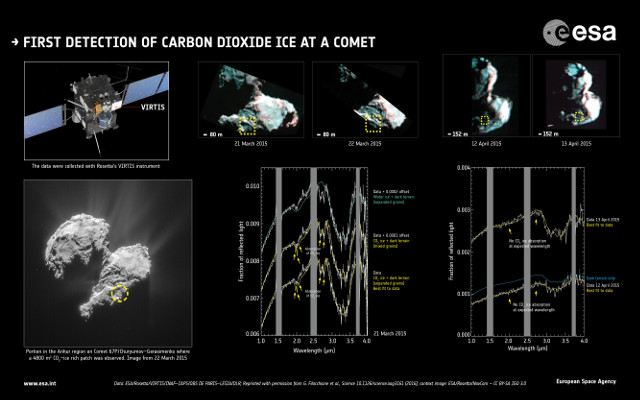
Two articles published in the journal “Science” describe the discovery of dry ice, meaning frozen carbon dioxide, on the surface of the comet 67P/Churyumov-Gerasimenko. A team of researchers led by Gianrico Filacchione of the Italian National Institute for Astrophysics and another led by Sonia Fornasier the French LESIA-Observatoire de Paris and Université Paris Diderot used the observations conducted with the VIRTIS spectrometer aboard ESA’s Rosetta space probe to find for the first time dry ice on a comet’s nucleus.
The problem in finding dry ice on the surface of a comet is given by the fact that carbon dioxide is very volatile, meaning the ice easily passes to the gaseous state at temperatures of -200° Celsius. The consequence is that in general it’s stable enough to be found only in very cold underground deposits even if carbon dioxide is one of the most common compounds in comets.
Winter in the southern region of Anhur on the comet 67P/Churyumov-Gerasimenko allowed to find a dry ice deposit along with two of water ice deposits. The key observations were carried out on March 21 and 22, 2015, when winter was ending in the comet’s southern hemisphere after about four years. This means that during that time the surface hadn’t been hit by sunlight and consequently the temperatures were very low.
The VIRTIS (Visible Infrared Thermal Imaging Spectrometer) instrument identified the dry ice on an area of about 80 to 60 meters. It constituted about 0.1% of the area and based on that discovery it was possible to examine other data that allowed to reconstruct the evolution of the dry ice.
That area started emerging from winter in December 2014 and the dry ice disappeared in April 2015. The observations made during that period allowed to understand how its distribution evolved and to evaluate the erosion occurred on the surface of that area.
After the disappearance of the dry ice, the Rosetta space probe discovered in that area two water ice deposits. This is not news, so much that in January 2016 an article published in the journal “Nature” described a specific research on the presence of water ice exposed on the surface of the comet 67P/Churyumov-Gerasimenko.
Because of the exposure of different materials, the surface changed color over time. As it approached the Sun the comet became bluer because of the intense activity that lifted large amounts of dust. When it moved away from the Sun again, the comet became redder, as it was before the surface activity started. Locally, there have been several color variations connected to the water cycle.
These two studies added more information on the composition and history of the comet 67P/Churyumov-Gerasimenko’s nucleus. The mission of the Rosetta space probe was completed at the end of September but the data collected will keep on being used to continue its studies.

